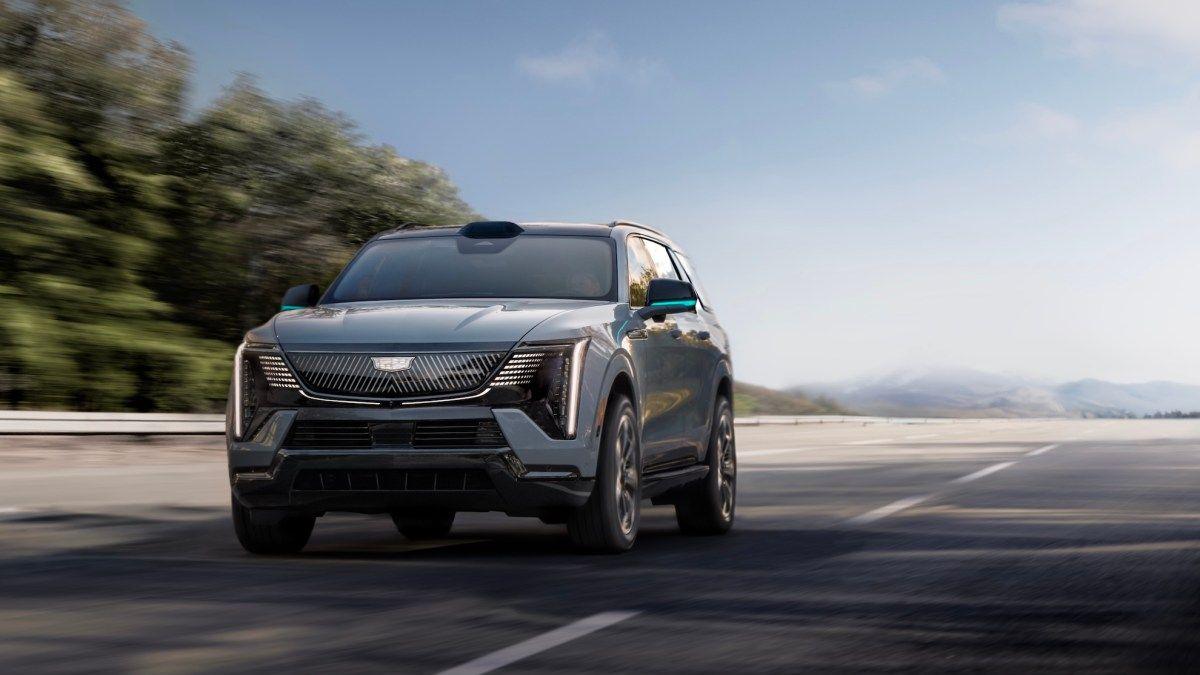GM's Software Revolution: AI and Automated Driving Take Center Stage in Vehicle Overhaul
2 Sources
2 Sources
[1]
GM's under-the-hood overhaul puts AI and automated driving at the center | TechCrunch
General Motors is overhauling the electrical and computational guts of its future vehicles in a bid to deliver faster software, more capable automated driving features, and a custom, conversational AI assistant. The result of this overhaul will debut in 2027 in the Cadillac Escalade IQ. The U.S. automaker, which unveiled its plans at an event Wednesday in New York City, said a new electric architecture and centralized computing platform will be the foundation for all of its future gas-powered and electric vehicles, starting in 2028. The next-generation supercomputer, Nvidia Drive AGX Thor, will power the compute unit -- the result of an expanded partnership between GM and Nvidia that was announced in March. This under-the-hood renovation is a required step if the company wants to introduce more services and features, like a conversational AI assistant or a system that allows a car to safely navigate highways while the driver watches a movie -- two products that GM said it is working on and will bring to future vehicles. It would also allow GM to improve the performance of its vehicles, fix problems, or add new features to its infotainment systems via software updates -- all of which would make it more competitive with Tesla and the rising threat of Chinese automakers. GM Chief Product Officer Sterling Anderson said he's been focused on accelerating the rollout of this new architecture since joining the company in May because it "brings a lot of goodness," like bandwidth and a "dramatic increase in the compute." It's part of Anderson's broader goal of getting technologically advanced products into consumers' hands faster. "Going forward, on the core business, my focus has really been around speed, user experience of the product, and profitability," Anderson told TechCrunch. "We're looking across the business to find opportunities to dramatically reduce the development time for our vehicle platforms. Today, it's on the order of four to five years. I'd like to get it closer to two." Inside most modern vehicles, including GM brands Buick, Chevrolet, Cadillac, and GMC, are dozens of small computers that handle everything from the infotainment and safety systems to propulsion, steering, and braking. The number of these computers, called electronic control units or ECUs, has risen over the past decade as automakers have added more services and features. Tesla, which took a ground-up, software-first approach, was able to outpace established brands with more computing power and the ability to roll out new features and improve performance through wireless software updates, similar to iPhones or Android-based smartphones. Legacy automakers have spent years, and billions of dollars, trying to catch up. The industry widely agrees that part of the solution is to change the underlying hardware architecture to handle the growing computational appetites of infotainment features, safety systems, and automated driving. GM is taking a similar, although not identical, approach to the zonal architectures used by Tesla and Rivian. GM said it will consolidate dozens of ECUs into a unified computer core that will coordinate every subsystem in the vehicle in real time. That core will be connected to three aggregators -- hubs that will convert signals from hundreds of sensors in the vehicle into a unified digital language and then route commands back to the correct hardware. The upshot: the central computing platform will connect every system in the car, including propulsion, steering, braking, infotainment, and safety, through a high-speed Ethernet backbone. GM calls the plan a "full reimagining" of how its vehicles are designed, updated, and improved over time. The end result, GM claims, will be vehicles with 10 times more over-the-air software update capacity, 1,000 times more bandwidth, and up to 35 times more AI performance for autonomy and advanced features. GM has been on this software-centric, reimagining-the-vehicle road for several years. In 2020, GM rolled out an updated hardware architecture called Vehicle Intelligence Platform (VIP) to allow for greater data processing power and over-the-air software updates. The following year, GM unveiled a cloud-based, end-to-end software platform called Ultifi that executives promised would make vehicles more capable and give drivers access to in-car subscriptions and new apps and services through over-the-air updates. The Ultifi branding has since been dropped, but it exists in GM's newest models and is the software that operates on top of the VIP architecture. GM continued its bid for a more software-centric vehicle in 2022 when it consolidated dozens of computers used to operate the infotainment system into a single computing platform.
[2]
'Radical Simplification': GM's Software-Defined Vehicle Era Is Arriving Soon
GM will roll out these upgrades to both fully electric and combustion engine models. General Motors is planning to build a new generation of vehicles that will feel more like Teslas and Rivians, and less like today's Chevys and Cadillacs. The automaker announced on Wednesday that, starting from 2028, its vehicles will incorporate a highly powerful centralized computer and next-generation electrical architecture, enabling them to become more autonomous over time and more rapidly improve through over-the-air upgrades. This marks a key stride in GM's software-defined vehicle era, a concept that Tesla first pioneered and the entire auto industry is now trying to adapt to. But unlike GM's rivals, which are marrying high-tech software mainly with EVs, GM said its zonal architecture is powertrain-agnostic, meaning even combustion engine vehicles will benefit from it. "Our system advances far beyond the zonal architecture others have announced," Dave Richardson, GM's senior vice president of software and services engineering, told reporters during the GM Forward event in New York on Wednesday. "We centralize core systems like propulsion, body, lighting, thermal and chassis to enable broader software reuse across the vehicle. And at the heart of this transformation is an in-house design, liquid-cooled central compute unit, which is going to enable faster development cycles, more efficient software updates and seamless scalability across every GM brand," he added. GM said the Cadillac Escalade IQ will be the first to receive the upgrade in 2028, featuring fewer onboard computers and modules that will enable faster software updates and improve reliability. The updates will allow GM vehicles to always be "connected, awake and available, with near instant responses to remote commands." The Escalade IQ will also be the first GM vehicle to get eyes-off driving (it's already hands-off on select highways), taking its already popular Super Cruise driver-assistance system to the next level. The upgrade comes courtesy of a LIDAR sensor and a new Nvidia AGX Drive Thor computing platform. And for the first time, GM said Super Cruise will be able to drive off the highways too, cautiously expanding into more complex urban environments. As GM moves deeper into autonomous driving, reliability and computing power will only become more critical. "It's not often described as a robot, but that's what it is, and as we build this intelligence into it, it has to continue to work flawlessly at high speeds," GM's chief product officer, Sterling Anderson, told reporters. The automaker said that it's no stranger to rolling out software updates en masse. Some 4.5 million GM vehicles are already capable of receiving over-the-air updates, thanks to the Vehicle Intelligence Platform (VIP) that was upgraded in 2022 to incorporate infotainment and advanced driver assistance systems (ADAS) onto a single computing platform. That was just the first step towards software-defined vehicles, the smartphones on wheels that the auto industry has been talking a big game about for years. GM thinks now it's ready to go all in. The Nvidia AGX Drive Thor will serve as the main computer on future GM vehicles. That will not only consolidate infotainment and ADAS functions but also connect everything else, from propulsion and steering to braking and other safety systems, through an Ethernet backbone. In theory, that means fewer wires connecting each system separately, which saves weight and reduces complexity. It will also allow faster communication between different vehicle functions. We've seen other automakers do that too -- Rivian said zonal architecture helped it save more than two miles of wiring on the upcoming R2, leading to significant weight savings. A traditional car might use over 100 different electronic control units that each handle a discrete task and don't communicate with the others. A zonal architecture simplifies the system into a smaller number of far more powerful and coordinated computers. For GM vehicles, this zonal overhaul will mean 10 times more software updates compared to current systems, real-time safety updates for things such as Super Cruise and a system that has room to continuously grow and become more capable. GM said this allows for "hardware freedom" and "radical simplification," meaning certain components remain isolated from the software layer and can be upgraded without rewriting the code, such as brake actuators, cameras, in-vehicle screens, and more. Nvidia says its Drive AGX Thor centralized artificial intelligence computer can perform up to 1,000 trillion operations per second (TOPS), which would enable vehicles to constantly gather data and make real-time self-driving decisions on the road. However, as we've seen with Tesla, Volkswagen and even the current generation of GM vehicles, SDVs are anything but easy. Automakers' early efforts have been marred by bugs and glitches, including sudden power losses, digital keys not functioning, and leaving drivers stranded. Still, this is the path pretty much the entire auto industry is moving towards. Simpler and more powerful computers are also what's needed to deliver more autonomous vehicles. "Our architecture, our batteries, electrical systems, computing and vehicle architectures that bring our cars to life and enable what we can do in software," Anderson said. "Then comes the intelligence layer. This largely lies in software. This is where we enable our vehicles to perceive their environment, understand their occupants and adapt intelligently to every circumstance." And this won't just be limited to the expensive Escalade. GM said every future model will be built on this same advanced platform.
Share
Share
Copy Link
General Motors announces a major overhaul of its vehicle architecture, focusing on AI and automated driving capabilities. The new system, set to debut in 2027, promises faster software updates, more advanced features, and improved performance across both electric and gas-powered vehicles.

GM's Bold Move Towards Software-Defined Vehicles
General Motors (GM) is set to revolutionize its vehicle lineup with a comprehensive overhaul of the electrical and computational systems that power its cars. This ambitious project, unveiled at an event in New York City, aims to position GM at the forefront of the automotive industry's shift towards software-defined vehicles
1
.The Heart of the Revolution: Centralized Computing
At the core of GM's transformation is a new electric architecture and centralized computing platform, scheduled to debut in the 2027 Cadillac Escalade IQ. This system will serve as the foundation for all of GM's future vehicles, both electric and gas-powered, starting in 2028
1
.The centerpiece of this new architecture is the Nvidia Drive AGX Thor, a next-generation supercomputer resulting from an expanded partnership between GM and Nvidia. This powerful central compute unit will consolidate dozens of electronic control units (ECUs) into a unified core, coordinating every subsystem in the vehicle in real-time
2
.Promises of Enhanced Performance and Features
GM's new system boasts impressive capabilities:
- 10 times more over-the-air software update capacity
- 1,000 times more bandwidth
- Up to 35 times more AI performance for autonomy and advanced features
1
These improvements will enable GM to introduce more sophisticated services and features, including a conversational AI assistant and advanced automated driving capabilities
1
.Advancing Automated Driving
The Cadillac Escalade IQ will be the first GM vehicle to feature 'eyes-off' driving, taking the popular Super Cruise system to the next level. This upgrade includes a LIDAR sensor and the new Nvidia AGX Drive Thor computing platform, allowing Super Cruise to cautiously expand into more complex urban environments beyond highways
2
.Related Stories
A Unified Approach
Unlike some competitors who are focusing on electric vehicles for their high-tech software integration, GM's zonal architecture is designed to be powertrain-agnostic. This means that even combustion engine vehicles will benefit from these advanced capabilities
2
.Challenges Ahead
While GM's vision for software-defined vehicles is ambitious, the automotive industry has faced challenges in implementing such systems. Early efforts by various automakers have been plagued by bugs and glitches, including sudden power losses
2
. GM will need to navigate these potential pitfalls as it rolls out its new architecture.As the automotive landscape continues to evolve, GM's bold move towards software-defined vehicles represents a significant step in its efforts to compete with tech-forward companies like Tesla and emerging Chinese automakers. The success of this initiative could reshape the future of GM and the broader automotive industry.
References
Summarized by
Navi
Related Stories
GM's Ambitious AI-Driven Future: Eyes-Off Driving and Advanced Vehicle Intelligence
22 Oct 2025•Technology

GM to Integrate Google Gemini AI Assistant in Vehicles, Plans to Phase Out Android Auto and CarPlay
22 Oct 2025•Technology

Nvidia Expands AI Partnerships for Next-Generation Autonomous Vehicles
07 Jan 2025•Technology

Recent Highlights
1
OpenAI declares code red as Google's Gemini gains 200 million users in three months
Technology

2
DeepSeek releases open-source AI models that rival GPT-5 and Gemini at fraction of the cost
Technology

3
AI Chatbots Sway Voters More Effectively Than Traditional Political Ads, New Studies Reveal
Science and Research





